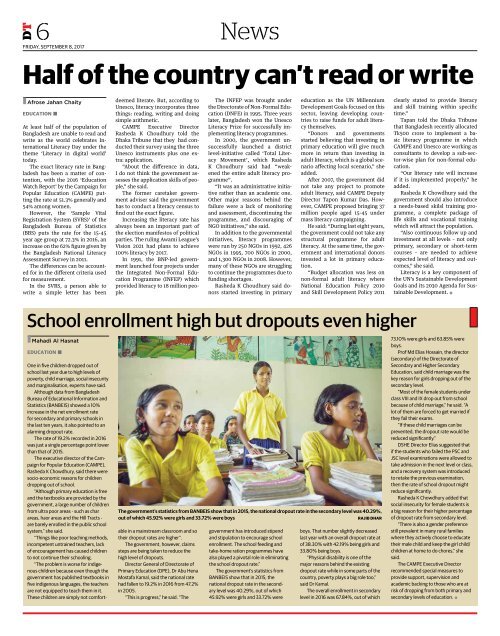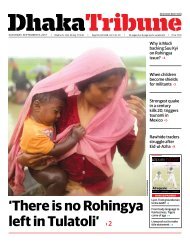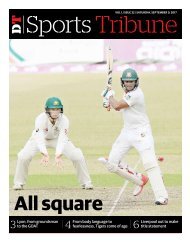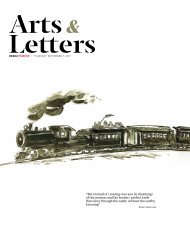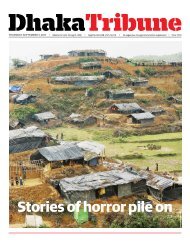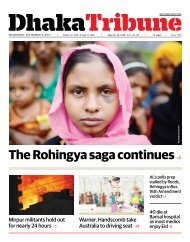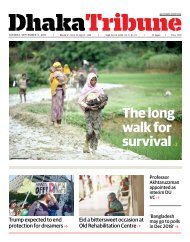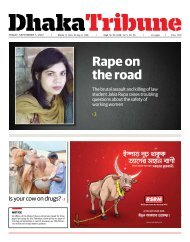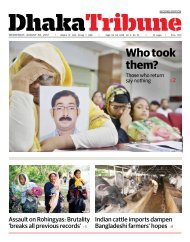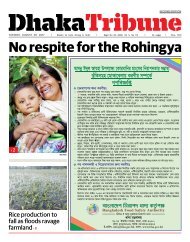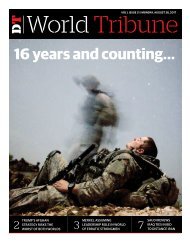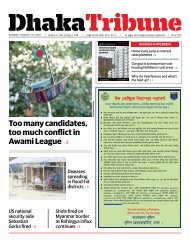e_Paper, Friday, September 8, 2017
Create successful ePaper yourself
Turn your PDF publications into a flip-book with our unique Google optimized e-Paper software.
6<br />
FRIDAY, SEPTEMBER 8, <strong>2017</strong><br />
DT<br />
News<br />
Half of the country can’t read or write<br />
• Afrose Jahan Chaity<br />
EDUCATION <br />
At least half of the population of<br />
Bangladesh are unable to read and<br />
write as the world celebrates International<br />
Literacy Day under the<br />
theme ‘Literacy in digital world’<br />
today.<br />
The exact literacy rate in Bangladesh<br />
has been a matter of contention,<br />
with the 2016 ‘Education<br />
Watch Report’ by the Campaign for<br />
Popular Education (CAMPE) putting<br />
the rate at 51.3% generally and<br />
54% among women.<br />
However, the ‘Sample Vital<br />
Registration System (SVRS)’ of the<br />
Bangladesh Bureau of Statistics<br />
(BBS) puts the rate for the 15-45<br />
year age group at 72.3% in 2016, an<br />
increase on the 62% figure given by<br />
the Bangladesh National Literacy<br />
Assessment Survey in 2011.<br />
The differences can be accounted<br />
for in the different criteria used<br />
for measurement.<br />
In the SVRS, a person able to<br />
write a simple letter has been<br />
deemed literate. But, according to<br />
Unesco, literacy incorporates three<br />
things: reading, writing and doing<br />
simple arithmetic.<br />
CAMPE Executive Director<br />
Rasheda K Choudhury told the<br />
Dhaka Tribune that they had conducted<br />
their survey using the three<br />
Unesco instruments plus one extra:<br />
application.<br />
“About the difference in data,<br />
I do not think the government assesses<br />
the application skills of people,”<br />
she said.<br />
The former caretaker government<br />
adviser said the government<br />
has to conduct a literacy census to<br />
find out the exact figure.<br />
Increasing the literacy rate has<br />
always been an important part of<br />
the election manifestos of political<br />
parties. The ruling Awami League’s<br />
Vision 2021 had plans to achieve<br />
100% literacy by <strong>2017</strong>.<br />
In 1991, the BNP-led government<br />
launched four projects under<br />
the Integrated Non-Formal Education<br />
Programme (INFEP) which<br />
provided literacy to 18 million people.<br />
The INFEP was brought under<br />
the Directorate of Non-Formal Education<br />
(DNFE) in 1995. Three years<br />
later, Bangladesh won the Unesco<br />
Literacy Prize for successfully implementing<br />
literacy programmes.<br />
In 2000, the government unsuccessfully<br />
launched a district<br />
level-initiative called ‘Total Literacy<br />
Movement’, which Rasheda<br />
K Choudhury said had “weakened<br />
the entire adult literacy programme”.<br />
“It was an administrative initiative<br />
rather than an academic one.<br />
Other major reasons behind the<br />
failure were a lack of monitoring<br />
and assessment, discontinuing the<br />
programme, and discouraging of<br />
NGO initiatives,” she said.<br />
In addition to the governmental<br />
initiatives, literacy programmes<br />
were run by 250 NGOs in 1992, 426<br />
NGOs in 1995, 700 NGOs in 2000,<br />
and 1,300 NGOs in 2008. However,<br />
many of these NGOs are struggling<br />
to continue the programmes due to<br />
funding shortages.<br />
Rasheda K Choudhury said donors<br />
started investing in primary<br />
education as the UN Millennium<br />
Development Goals focused on this<br />
sector, leaving developing countries<br />
to raise funds for adult literacy<br />
themselves.<br />
“Donors and governments<br />
started believing that investing in<br />
primary education will give much<br />
more in return than investing in<br />
adult literacy, which is a global scenario<br />
affecting local scenario,” she<br />
added.<br />
After 2007, the government did<br />
not take any project to promote<br />
adult literacy, said CAMPE Deputy<br />
Director Tapon Kumar Das. However,<br />
CAMPE proposed bringing 37<br />
million people aged 15-45 under<br />
mass literacy campaigning.<br />
He said: “During last eight years,<br />
the government could not take any<br />
structural programme for adult<br />
literacy. At the same time, the government<br />
and international donors<br />
invested a lot in primary education.<br />
“Budget allocation was less on<br />
non-formal adult literacy where<br />
National Education Policy 2010<br />
and Skill Development Policy 2011<br />
clearly stated to provide literacy<br />
and skill training within specific<br />
time.”<br />
Tapan told the Dhaka Tribune<br />
that Bangladesh recently allocated<br />
Tk500 crore to implement a basic<br />
literacy programme in which<br />
CAMPE and Unesco are working as<br />
consultants to develop a sub-sector-wise<br />
plan for non-formal education.<br />
“Our literacy rate will increase<br />
if it is implemented properly,” he<br />
added.<br />
Rasheda K Chowdhury said the<br />
government should also introduce<br />
a needs-based skilsl training programme,<br />
a complete package of<br />
life skills and vocational training<br />
which will attract the population.<br />
“Also continuous follow up and<br />
investment at all levels – not only<br />
primary, secondary or short-term<br />
courses – are needed to achieve<br />
expected level of literacy and outcomes,”<br />
she said.<br />
Literacy is a key component of<br />
the UN’s Sustainable Development<br />
Goals and its 2030 Agenda for Sustainable<br />
Development. •<br />
School enrollment high but dropouts even higher<br />
• Mahadi Al Hasnat<br />
EDUCATION <br />
The government’s statistics from BANBEIS show that in 2015, the national dropout rate in the secondary level was 40.29%,<br />
out of which 45.92% were girls and 33.72% were boys<br />
RAJIB DHAR<br />
One in five children dropped out of<br />
school last year due to high levels of<br />
poverty, child marriage, social insecurity<br />
and marginalisation, experts have said.<br />
Although data from Bangladesh<br />
Bureau of Educational Information and<br />
Statistics (BANBEIS) showed a 10%<br />
increase in the net enrollment rate<br />
for secondary and primary schools in<br />
the last ten years, it also pointed to an<br />
alarming dropout rate.<br />
The rate of 19.2% recorded in 2016<br />
was just a single percentage point lower<br />
than that of 2015.<br />
The executive director of the Campaign<br />
for Popular Education (CAMPE),<br />
Rasheda K Chowdhury, said there were<br />
socio-economic reasons for children<br />
dropping out of school.<br />
“Although primary education is free<br />
and the textbooks are provided by the<br />
government, a large number of children<br />
from ultra poor areas - such as char<br />
areas, haor areas and the Hill Tracts -<br />
are barely enrolled in the public school<br />
system,” she said.<br />
“Things like poor teaching methods,<br />
incompetent untrained teachers, lack<br />
of encouragement has caused children<br />
to not continue their schooling.<br />
“The problem is worse for indigenous<br />
children because even though the<br />
government has published textbooks in<br />
five indigenous languages, the teachers<br />
are not equipped to teach them in it.<br />
These children are simply not comfortable<br />
in a mainstream classroom and so<br />
their dropout rates are higher”.<br />
The government, however, claims<br />
steps are being taken to reduce the<br />
high level of dropouts.<br />
Director General of Directorate of<br />
Primary Education (DPE), Dr Abu Hena<br />
Mostafa Kamal, said the national rate<br />
had fallen to 19.2% in 2016 from 47.2%<br />
in 2005.<br />
“This is progress,” he said. “The<br />
government has introduced stipend<br />
and stipulation to encourage school<br />
enrollment. The school feeding and<br />
take-home ration programmes have<br />
also played a pivotal role in eliminating<br />
the school dropout rate.”<br />
The government’s statistics from<br />
BANBEIS show that in 2015, the<br />
national dropout rate in the secondary<br />
level was 40.29%, out of which<br />
45.92% were girls and 33.72% were<br />
boys. That number slightly decreased<br />
last year with an overall dropout rate at<br />
of 38.30% with 42.19% being girls and<br />
33.80% being boys.<br />
“Physical disability is one of the<br />
major reasons behind the existing<br />
dropout rate while in some parts of the<br />
country, poverty plays a big role too,”<br />
said Dr Kamal.<br />
The overall enrollment in secondary<br />
level in 2016 was 67.84%, out of which<br />
73.10% were girls and 63.85% were<br />
boys.<br />
Prof Md Elias Hossain, the director<br />
(secondary) of the Directorate of<br />
Secondary and Higher Secondary<br />
Education, said child marriage was the<br />
key reason for girls dropping out of the<br />
secondary level.<br />
“Most of the female students under<br />
class VIII and IX drop out from school<br />
because of child marriage,” he said. “A<br />
lot of them are forced to get married if<br />
they fail their exams.<br />
“If these child marriages can be<br />
prevented, the dropout rate would be<br />
reduced significantly.”<br />
DSHE Director Elias suggested that<br />
if the students who failed the PSC and<br />
JSC level examinations were allowed to<br />
take admission in the next level or class,<br />
and a recovery system was introduced<br />
to retake the previous examination,<br />
then the rate of school dropout might<br />
reduce significantly.<br />
Rasheda K Chowdhury added that<br />
social insecurity for female students is<br />
a big reason for their higher percentage<br />
of dropout rate from secondary level.<br />
“There is also a gender preference<br />
still prevalent in many rural families<br />
where they actively choose to educate<br />
their male child and keep the girl child/<br />
children at home to do chores,” she<br />
said.<br />
The CAMPE Executive Director<br />
recommended special measures to<br />
provide support, supervision and<br />
academic backing to those who are at<br />
risk of dropping from both primary and<br />
secondary levels of education. •


